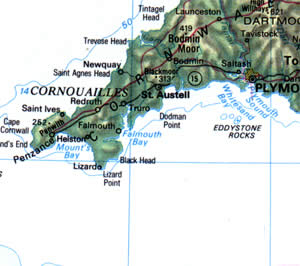Pytheas arrives at the tip of English Cornwall where the tin quarries are exploited. He negotiates on behalf of Marseille and details the tin industry.
Pytheas now sails due north. In three days of sailing he crosses the Channel and lands at the tip of Cornwall, near present-day Plymouth, in Great Britain.
 |
Cornwall and the Cassiterides Islands |
Two ancient texts allow us to understand the genesis of tin. The first is by Diodorus, whose texts are known to be strongly inspired by Timaeus. The second comes to us from Pliny the Elder, also taking his sources from Timaeus, who wrote about 40 years after Pytheas, using him for his description of the Atlantic.
“The inhabitants of Britain who live on a promontory called Belerion are especially friendly with foreigners and have adopted a civilized life because of their relations with merchants and other peoples. They are the ones who work the tin, treating it in an ingenious way. These blocks, rocks, contain earthy parts from which they extract the ore which they melt to clean it of impurities. Then they work the tin into ingots and transport it to an island called Ictis opposite Britain. At low tide, the space between this island and the land is dry and they can take tin in large quantities with their carts. (and something special happens for the neighboring islands that are between Europe and Brittany at high tide the passage between them and the mainland becomes full, and they have the appearance of islands, but at low tide the sea recedes and leaves a large space dry and they look like a peninsula). On the island of Ictis the merchants buy tin from the natives and transport it from here across the Strait of Galate, the canal and, finally making their way on foot through Gaul for thirty days they transport their merchandise on horseback to the mouths of the Rhone. "(G20). He adds a little further that the tin is embarked for Massalia and Narbo (Narbonne).
Pliny also reports this text to us: "Tymée, says that an island named Mictis is located six days' sailing from Britain where tin is found and that the Britons cross in wicker boats covered with sewn skins" (G21).
There is not much to say about Diodorus' text. No doubt as would be, if we knew it, that of Pytheas. There he discovered the "Cassiterides Islands" and the tin industry is clearly explained. The Belerion promontory is the English Finistère. This cape was called Bolerium a few centuries later. The site of Ictis is an important center. Where exactly is it? We generally think of Mont St Michel (English), in Penzance Bay. In 1907, drachmas (43 pieces) were found there, imitations of Massaliote coins. Coins do not mean an industrial settlement. There are no archaeological traces on the site. Perhaps they are buried in the sand? Further east, at Mount Batten, archaeological remains do indeed exist. There are traces of the Bronze Age as well as a profusion of objects dating from the 6th to the 2nd century BC.

